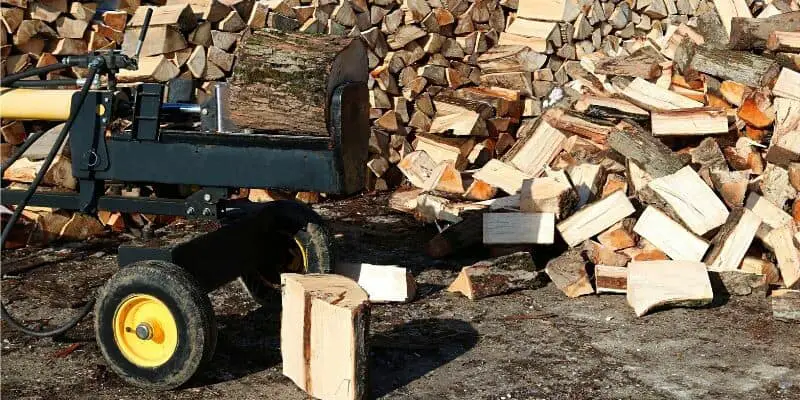Do you own a log splitter, but it has been giving you trouble by not starting as it should? If so, then you are in the right place at the right time.
Log splitter start issues are caused by problems like a dirty carburetor, failed spark plug, bad gasoline, stale gas, and more. If you’ve left the gas in the fuel tank for over 6 months without adding a fuel stabilizer or the recoil starter isn’t spinning the engine, it could create ignition issues.
In this guide, you’ll get to know about log splitter starting issues, why won’t my log splitter start, the power source problems of different types of log splitters, and more. Continue reading to get all the answers that you are looking for.
Why won’t my log splitter start?
There are multiple reasons why log splitter won’t start. Some of the most common ones include a dirty carburetor, failed spark plugs, bad gasoline, or a broken recoil starter.
If you’ve got stale gas in your log splitter, it will prevent the engine from starting. If you have left gas in the fuel tank for over 6 months without adding a fuel stabilizer, you should drain the tank and then fill it with fresh gas. After that, add a fuel stabilizer to the gas for keeping it fresh. Bad gasoline can end up clogging the carburetor. You’ll have to clean and rebuild the carburetor if the engine doesn’t start even after replacing the gas in the fuel tank. Moreover, you can replace the carburetor in case it is too clogged to clean.
A dirty spark plug will not ignite the fuel for starting the engine. You’ll have to do a full tune-up, including replacing the spark plug, oil, and air filter. If the recoil starter isn’t spinning the engine when you’re pulling the starter rope, then you will likely have to replace the recoil starter.
Different types of log splitters and power source problems
Troubleshooting why won’t my log splitter start isn’t as daunting a task as some may think. Before troubleshooting the power source issue, you’ll first want to know what powers your log splitter and how you can avoid any power source problems stopping the log splitter from starting.
Gas-powered log splitters
Gas-powered log splitters come powered by a 4-stroke engine, and it requires regular maintenance. If you neglect the engine, chances are that you might have issues with the log splitter working properly. This is especially true if the log splitter won’t start or keep on running.
You should keep the engine in proper working order by providing the right levels of gas and engine oil. Moreover, make sure that you rain the fluids when placed in storage for long periods of time. Old oil and gas can easily clog up the carburetor while causing it to stop running. The spark plug should be checked regularly and replaced if any carbon build-up is present. This is among the main reasons why log splitter won’t start.
You should also make sure that you’re cleaning or changing the air filters, especially after use, as fine sawdust can easily clog the filter and block the airflow. Gas engines are a simple design and pretty easy to work on. Start pulls, hoses, and other parts are easy to replace once you narrow down the problem.
Electricity-powered log splitter
One of the most common issues with an electricity-powered log splitter not starting is the power source. You should make sure that you’re checking the outlets, as they must be in working order. Moreover, check to ensure that you aren’t blowing a fuse. Sometimes, the extension cord that you’re using could be a problem too.
Over time, they can dry out and crack, which creates a poor electrical connection or breaks the wires inside. Dispose of the extension cord that you feel isn’t working as it should. Moreover, always prefer using a cord rated for the number of amps that you’re drawing for optimal performance.
Unfortunately, electric engines aren’t something that you can work on easily. Often, they’ll require a professional if the problem is located in the engine. At times, the cost of the engine repair could be almost as much as what a new splitter may cost.
Manual hydraulic log splitter
When you’re using a manual hydraulic log splitter, you yourself will be the power source for the log splitter. These simple designs are easy to troubleshoot as there isn’t much to the overall design. If your foot pedals or rods aren’t moving as they should, you should give them a decent oiling to break up any rust or dirt that might have been stuck in the joints. Moreover, ensure that they are properly attached if they could be removed for storage purposes.
Dead or weak battery won’t let the log splitter start
Unsurprisingly, a dead or weak battery is another leading cause of the log splitter not starting. If the log splitter hasn’t been used in months, most likely the battery will either be dead or too weak to start. One of the quickest ways of determining if the battery is the issue is to jump-start the log splitter’s engine with your car’s battery. However, you should make sure that you shut off the car’s engine before attempting to jump-start the log splitter. If the car’s engine is running, you could end up frying the log splitter battery.
If you can jump-start the engine with your car battery, you’ll know that the log splitter battery is the problem. A battery isn’t a “tank” of electricity, as you cannot use some while infinitely storing the rest for later. A lead-acid battery is just a plastic box that holds a delicate balance of chemicals ready to produce electricity when the load is applied. Using a voltage meter will be the best way of determining the stage of charge for the battery.

A weak battery could cause all sorts of trouble. In fact, letting the battery sit unused will give you a 1% voltage loss per day. This is why it’s a great idea to keep your battery on a trickle charger when it isn’t being used. It is pretty common to repeatedly draw down the voltage in the battery when the engine’s charging circuit isn’t allowed sufficient time for charging the battery. Starting the engine via electricity and running it for an hour or so will consume more battery power than it’ll replace.
If you’ve got a voltage meter handy, check the reading of the battery when you’re starting the engine. If it drops below 11 volts, the log splitter’s battery is too weak to start the engine. A reading of 10.5 volts or lower is an indication of a dead cell.
FAQs
How do you start a log splitter?
For starting a log splitter, you should first turn on the fuel tap and the engine switch. After that, engage the choke if it is a cold start. Now, pull the starter cord until a slight resistance is felt before letting the starter cord recoil and give some sharp pulls until the engine starts.
Why won’t your log splitter split wood?
The log splitter might have an underlying issue, which you’ll need to find out and troubleshoot. In most cases, this issue is due to the log splitter not being operated on level ground.
How to start your log splitter in cold weather?
For ensuring that your log splitter starts in cold, your best option would be to start it with a magnetic block heater installed. If the log splitter doesn’t stay warm enough after you start it, you can leave the block heater on during use.
What are the common reasons for the log splitter not starting?
Commonly, log splitter start issues are caused by a dirty carburetor, failed spark plug, bad gasoline, stale gas, and more.


